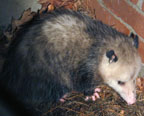 Didelphis virginiana (Virginia opossum) (Lexington, 2/27/01 9pm)
Didelphis virginiana (Virginia opossum) (Lexington, 2/27/01 9pm)Since all of our mammals are generally pretty big, especially compared to spiders or insects, you might think it would be easy to get pictures of all of them -- it isn't. Many are nocturnal. Others, like moles & voles, pretty much stay underground. I have left off the list all of the ocean dwellers because Lexington isn't on the coast.
Making the list of Massachusetts mammals was depressing. We have extirpated 8 species since Colonial times, including the Elk, American Marten, & Wolverine. We've also brought most large whale species to the edge of extinction. Also depressing is the biggest variety of mammals I've seen have been dead along the shoulder of Rt. 128 on my commute to work.
 Didelphis virginiana (Virginia opossum) (Lexington, 2/27/01 9pm)
Didelphis virginiana (Virginia opossum) (Lexington, 2/27/01 9pm)
 female
female 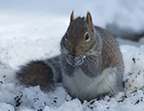 Sciurus carolinensis (Eastern Gray Squirrel) (Lower Vine Brook, 6/7/2009 5pm, 2/19/2010 2pm)
Sciurus carolinensis (Eastern Gray Squirrel) (Lower Vine Brook, 6/7/2009 5pm, 2/19/2010 2pm)
 Tamiasciurus hudsonicus (Red squirrel) (Lexington, 4/9/05 2pm)
Tamiasciurus hudsonicus (Red squirrel) (Lexington, 4/9/05 2pm)
Glaucomys sabrinus (Northern Flying Squirrel) May not be around anymore.
Glaucomys volans (Southern Flying Squirrel)
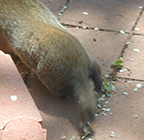
 Marmota monax (Woodchuck, Groundhog) (Lexington, 5/17/2003 1pm) Terrible photos, but this was a very shy and surprisingly speedy groundhog.
Marmota monax (Woodchuck, Groundhog) (Lexington, 5/17/2003 1pm) Terrible photos, but this was a very shy and surprisingly speedy groundhog.
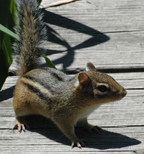
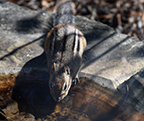
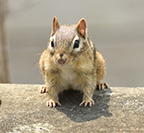 Tamius striatus, male (Eastern chipmunk) (Willard's Woods, 6/24/07 11am, Lower Vine Brook, 3/21/2020 3pm, Lower Vine Brook, 5/11/2023 11am) The chipmunk in the first photo & I played a little game on a boardwalk across the marsh. I'd look away and he'd try to race past me. As he got within about 6 feet, I'd turn and look at him. He'd stop and stare and then run away. Repeat. He finally got fed up and jumped down into the marsh.
Tamius striatus, male (Eastern chipmunk) (Willard's Woods, 6/24/07 11am, Lower Vine Brook, 3/21/2020 3pm, Lower Vine Brook, 5/11/2023 11am) The chipmunk in the first photo & I played a little game on a boardwalk across the marsh. I'd look away and he'd try to race past me. As he got within about 6 feet, I'd turn and look at him. He'd stop and stare and then run away. Repeat. He finally got fed up and jumped down into the marsh.
Castor canadensis (American Beaver)
Napaeozapus insignis (Woodland Jumping Mouse)
Zapus hudsonius (Meadow Jumping Mouse)
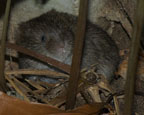
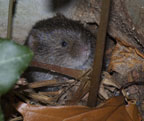
 Microtus pennsylvanicus (Meadow Vole) (Lower Vine Brook, 11/12/2012 9am (2), 12/10/2021 1pm) The first 2 photos are of one that is living in tunnels under our front garden. This entrance is in the window well. The third photo is of one that is living under the bird bath, I think, in the back yard.
Microtus pennsylvanicus (Meadow Vole) (Lower Vine Brook, 11/12/2012 9am (2), 12/10/2021 1pm) The first 2 photos are of one that is living in tunnels under our front garden. This entrance is in the window well. The third photo is of one that is living under the bird bath, I think, in the back yard.
Microtus pinetorum (Woodland Vole)
Myodes gapperi (Southern Red-backed Vole)
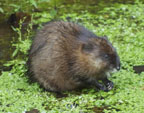
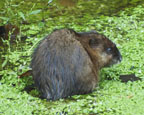 Ondatra zibethicus (Common Muskrat) (Lower Vine Brook, 10/1/11 12pm)
Ondatra zibethicus (Common Muskrat) (Lower Vine Brook, 10/1/11 12pm)
Synaptomys cooperi (Southern Bog Lemming, special concern)
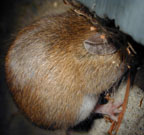
 Peromyscus leucopus (White-footed mouse) (Lexington, 9/20/02 10:30pm, 11/8/07 11pm) The first fellow was trying to squeeze into a tiny hole in the side of our house. Once I alerted our cat to the problem, and then pulled the mouse out of the hole by the tail (which our cat was too lazy to do), the problem was taken care of. The mouse on the right was more successful -- he or she made it into the house. Alas, it fell into an empty garbage can and was returned to the woods.
Peromyscus leucopus (White-footed mouse) (Lexington, 9/20/02 10:30pm, 11/8/07 11pm) The first fellow was trying to squeeze into a tiny hole in the side of our house. Once I alerted our cat to the problem, and then pulled the mouse out of the hole by the tail (which our cat was too lazy to do), the problem was taken care of. The mouse on the right was more successful -- he or she made it into the house. Alas, it fell into an empty garbage can and was returned to the woods.
Peromyscus maniculatus (North American Deermouse)
Mus musculus (House Mouse) Introduced from Europe.
Rattus norvegicus (Brown Rat) Introduced from Europe.
Erethizon dorsatum (North American Porcupine)
Lepus americanus (Snowshoe Hare)
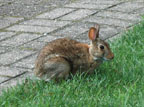 Sylvilagus floridanus (Eastern cottontail rabbit) (Lexington, 7/14/08 5pm)
Sylvilagus floridanus (Eastern cottontail rabbit) (Lexington, 7/14/08 5pm)
Sylvilagus transitionalis (New England Cottontail)
 Blarina brevicauda (Northern Short-tailed Shrew) (Lexington, 2/7/10 4pm) This one was darting in and out of its snow tunnels to pick up sunflower seeds.
Blarina brevicauda (Northern Short-tailed Shrew) (Lexington, 2/7/10 4pm) This one was darting in and out of its snow tunnels to pick up sunflower seeds.
Sorex cinereus (Cinereus Shrew)
Sorex dispar (Long-tailed Shrew, special concern)
Sorex fumeus (Smoky Shrew)
Sorex hoyi (American Pygmy Shrew)
Sorex palustris (American Water Shrew, special concern)
Condylura cristata (Star-nosed Mole)
Parascalops breweri (Hairy-tailed Mole)
Scalopus aquaticus (Eastern Mole)
Eptesicus fuscus (Big Brown Bat)
Lasiurus borealis (Eastern Red Bat)
Lasiurus cinereus (Hoary Bat)
Pipistrellus subflavus (Eastern Pipistrelle)
Lasionycteris noctivagans (Silver-haired Bat)
Myotis leibii (Eastern Small-footed Bat, special concern)
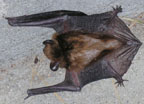 Myotis lucifugus (Little brown myotis) (Lexington, 4/28/05 9am)
Myotis lucifugus (Little brown myotis) (Lexington, 4/28/05 9am) 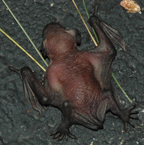 juvenile (Lexington, 6/24/07 9am) I was very suprised to find this bat on my kitchen steps. I had thought it was dead and went to get the shovel to bury it. When I returned it had moved a bit! When I tried to pick it up with the shovel, it made an impressive display of teeth and quite a nasty screech. I moved it into the woods in the hopes it would recover from whatever ailed it. I had hoped the Lexington Animal Control officer would pick it up and test it for rabies, but they wouldn't take it.
juvenile (Lexington, 6/24/07 9am) I was very suprised to find this bat on my kitchen steps. I had thought it was dead and went to get the shovel to bury it. When I returned it had moved a bit! When I tried to pick it up with the shovel, it made an impressive display of teeth and quite a nasty screech. I moved it into the woods in the hopes it would recover from whatever ailed it. I had hoped the Lexington Animal Control officer would pick it up and test it for rabies, but they wouldn't take it.
Myotis septentrionalis (Northern Myotis)
Lynx rufus (Bobcat)
Puma concolor (Cougar, Mountain Lion)
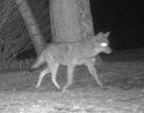 Canis latrans (Coyote) (Lower Vine Brook, 4/22/2020 11pm)
Canis latrans (Coyote) (Lower Vine Brook, 4/22/2020 11pm)
Vulpes vulpes (Red Fox)
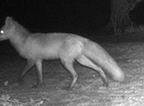
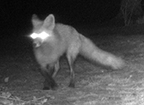 Urocyon cinereoargenteus (Gray Fox) (Lower Vine Brook, 4/22/2020 4am) This could be a red fox. Based on the fact that I can see a raccoon's black and white striped tail in infrared, I am guessing I'd see the white tip of a red fox's tail.
Urocyon cinereoargenteus (Gray Fox) (Lower Vine Brook, 4/22/2020 4am) This could be a red fox. Based on the fact that I can see a raccoon's black and white striped tail in infrared, I am guessing I'd see the white tip of a red fox's tail.
Ursus americanus (American Black Bear)
Lontra canadensis (North American River Otter)
Martes pennanti (Fisher)
Mustela erminea (Ermine)
Mustela frenata (Long-tailed Weasel)
Neovison vison (American Mink)
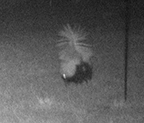 Mephitis mephitis (Striped Skunk) (Wildwood Park, Burlington, 9/18/2023 1am) It was successfully warding off a fox.
Mephitis mephitis (Striped Skunk) (Wildwood Park, Burlington, 9/18/2023 1am) It was successfully warding off a fox.
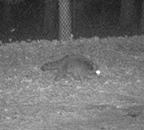
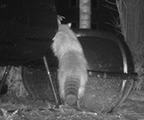
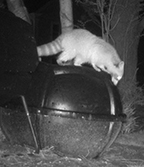
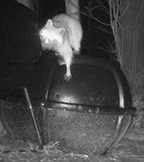
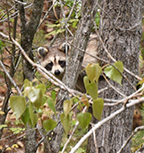 Procyon lotor (Raccoon) (Lower Vine Brook, 2/22/2020 2:42am, 5/2/2020 2am, 5/14/2022 3pm) Growing up in New Jersey raccoons were regulars at our garbage. We even had a mother with her cubs come into our screened porch through the cat door. Here in MA, I have seen very few out and about and many more squashed on the road.
Procyon lotor (Raccoon) (Lower Vine Brook, 2/22/2020 2:42am, 5/2/2020 2am, 5/14/2022 3pm) Growing up in New Jersey raccoons were regulars at our garbage. We even had a mother with her cubs come into our screened porch through the cat door. Here in MA, I have seen very few out and about and many more squashed on the road.
Alces americanus (Moose)
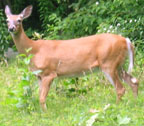
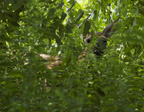 female or young
female or young 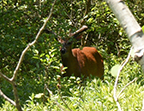 male Odocoileus virginianus (White-tailed deer) (Willard's Woods, 6/30/03 11am, 7/20/14 2pm, 5/29/2023 12pm) I am not a fan of deer. If they didn't carry ticks, I'd like them a little better, but there are still far too many of them in the Eastern U.S. We could kill two birds with one stone, so to speak, by reintroducing mountain lions throughout their original range. This would reduce the deer numbers while helping restore our biggest cat. There would undoubtably be more incidents of missing pets, but I think that would be well worth it (our cat was probably eaten by a coyote, so I am not unfeeling in these matters). I was stunned by how close I was to the deer in the second photo before I noticed it. I could almost feel the ticks leaping off it onto me.
male Odocoileus virginianus (White-tailed deer) (Willard's Woods, 6/30/03 11am, 7/20/14 2pm, 5/29/2023 12pm) I am not a fan of deer. If they didn't carry ticks, I'd like them a little better, but there are still far too many of them in the Eastern U.S. We could kill two birds with one stone, so to speak, by reintroducing mountain lions throughout their original range. This would reduce the deer numbers while helping restore our biggest cat. There would undoubtably be more incidents of missing pets, but I think that would be well worth it (our cat was probably eaten by a coyote, so I am not unfeeling in these matters). I was stunned by how close I was to the deer in the second photo before I noticed it. I could almost feel the ticks leaping off it onto me.
 ? (Lower Vine Brook, 3/28/09 1pm) I don't normally include photos of dead animals, but this jaw bone nestled in the moss made for a nice composition.
? (Lower Vine Brook, 3/28/09 1pm) I don't normally include photos of dead animals, but this jaw bone nestled in the moss made for a nice composition.
Seen, but not photographed:
At least 2 different species of bats, but I'm not sure which ones. One was quite large. The smaller were probably Brown bats.
Foxes -- I have definitely seen many red fox and I may have seen a gray fox. (Lexington)
I've seen several other small mammals, probably shrews or voles, as well as some more mice.
| Home | Insects | Spiders |